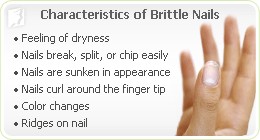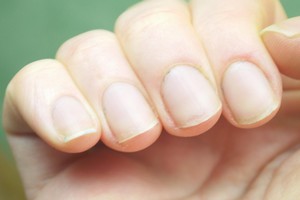

Disorders
That Show Up in the Nails
From the excellent book "Prescription For Nutritional
Healing" by Dr. James Balch, M.D. and Phyllis A. Balch,
C.N.C.
Nail
Problems
The nails protect the nerve-rich fingertips and tip toes from
injury. Nails are a substructure of the epidermis (the outer
layer of the skin) and are composed mainly of keratin, a type
of protein. The nail bed is the skin o which the nails grow.
Nails grow from 0.05 to 1.2 millimeters (approximately 1/500
to 1/200 inch) a week. If a nail is lost, it takes about seven
months to grow out fully.
The following are some of the changes that nutritional deficiencies
can produce in the nails
* A lack of protein, folic acid, and vitamin C causes hang-
nails. White bands across the nails are also an indication of
protein deficiency.
* A lack of vitamin A and calcium causes dryness and brittleness.
* A deficiency of the B vitamins causes fragility, with horizontal
and vertical ridges.
* Insufficient intake of vitamin B12 leads to excessive dryness,
very rounded and curved nail ends, and darkened nails.
* Iron deficiency may result in "spoon" nails (nails
that develop a concave shape) and/or vertical ridges.
* Zinc deficiency may cause the development of white spots on the nails.
* A lack of sufficient "friendly" bacteria (lactobacilli) in the body can result in the growth of fungus under and around nails.
Key Product: HSN-W ( Stands for Hair Skin Nails)

A lack of sufficient hydrochloric acid (HCI) contributes
to
splitting nails.
Nail changes may signify a number of disorders
elsewhere in the body.
These changes may indicate illness before any other symptoms
do. Seek medical attention if any of the following symptoms
are suspected.
Black, splinter like bits under the nails can be a sign
of infectious enclocarditis, a serious heart infection; other
heart disease; or a bleeding disorder.
Brittle nails signify possible iron deficiency, thyroid
problems, impaired kidney function, and circulation problems.
Brittle, soft, shiny nails without a moon may indicate
an overactive thyroid.
Dark nails and/or thin, flat, spoon-shaped nails are
a sign of vitamin
deficiency or anemia. Nails can also turn gray or dark if the
hands are placed in chemicals such as cleaning supplies (most
often bleach) or a substance to which one is allergic.
Deep blue nail beds show a pulmonary obstructive disorder
such as asthma or emphysema.
Downward-curved nail ends may denote heart, liver, or
respiratory problems.
Flat nails can denote Raynaud's disease.
Greenish nails, if not a result of a localized fungal
infection, may indicate an internal bacterial infection.
 A half-white nail with dark spots at the tip points to
possible kidney disease.
A half-white nail with dark spots at the tip points to
possible kidney disease.
An isolated dark-blue band in the nail bed, especially
in light-skinned people, can be a sign of skin cancer.
Nail beading (the development of bumps on the surface
of the nail) is a sign of rheumatoid arthritis.
Nails that broaden toward the tip and curve downward are
a sign of lung damage, such as from emphysema or exposure to
asbestos.
Nails that chip, peel, crack, or break easily show a
general nutritional deficiency and insufficient hydrochloric
acid and protein. Minerals are also needed.
Nails raised at the base, with small, white ends, show
a respiratory disorder such as emphysema or chronic bronchitis.
This type of nail may also simply be inherited.
Nails separated from the nail bed may signify a thyroid
disorder or a local infection.
Nails that have pitting resembling hammered brass indicate a tendency toward partial or total hair loss.
Pitted red-brown spots and frayed and split ends indicate
psoriasis; vitamin C, folic acid, and protein are needed.
Red skin around the cuticles can be indicative of poor metabolism of essential fatty acids
or of a connective tissue
disorder such as lupus.
Ridges can appear in the nails either vertically or horizontally.
Vertical ridges indicate poor general health, poor nutrient
absorption, and/or iron deficiency; they may also indicate a
kidney disorder. Horizontal ridges can occur as a result of
severe stress, either psychological or physical
such as from infection and/or disease. Ridges running up and
down the nails also indicate a tendency to develop arthritis.
 Thick nails may indicate that the vascular system is
weakening and the blood is not circulating property. They may
also be a sign of thyroid disease.
Thick nails may indicate that the vascular system is
weakening and the blood is not circulating property. They may
also be a sign of thyroid disease.
Thinning nails may signal lichen planus, an itchy skin disorder.
Two white horizontal bands that do not move as the nail
grows are a sign of hypoalbuminemia, a protein deficiency in the blood.
Unusually wide, square nails can suggest a hormonal disorder.
White lines show possible heart disease, high fever, or arsenic poisoning.
White lines across the nail may indicate a liver disease
If the white moon area of the nail turns red, it may indicate heart problems; if it turns slate blue, then
it can indicate either heavy metal poisoning (such as silver
poisoning) or lung trouble.
White nails indicate possible liver or kidney disorders
and/or anemia.
White nails with pink near the tips are a sign of cirrhosis
Yellow nails or an elevation of the nail tips can indicate
internal disorders long before other symptoms appear. Some of these are problems with the lymphatic system, respiratory
disorders, diabetes, and liver disorders.
|